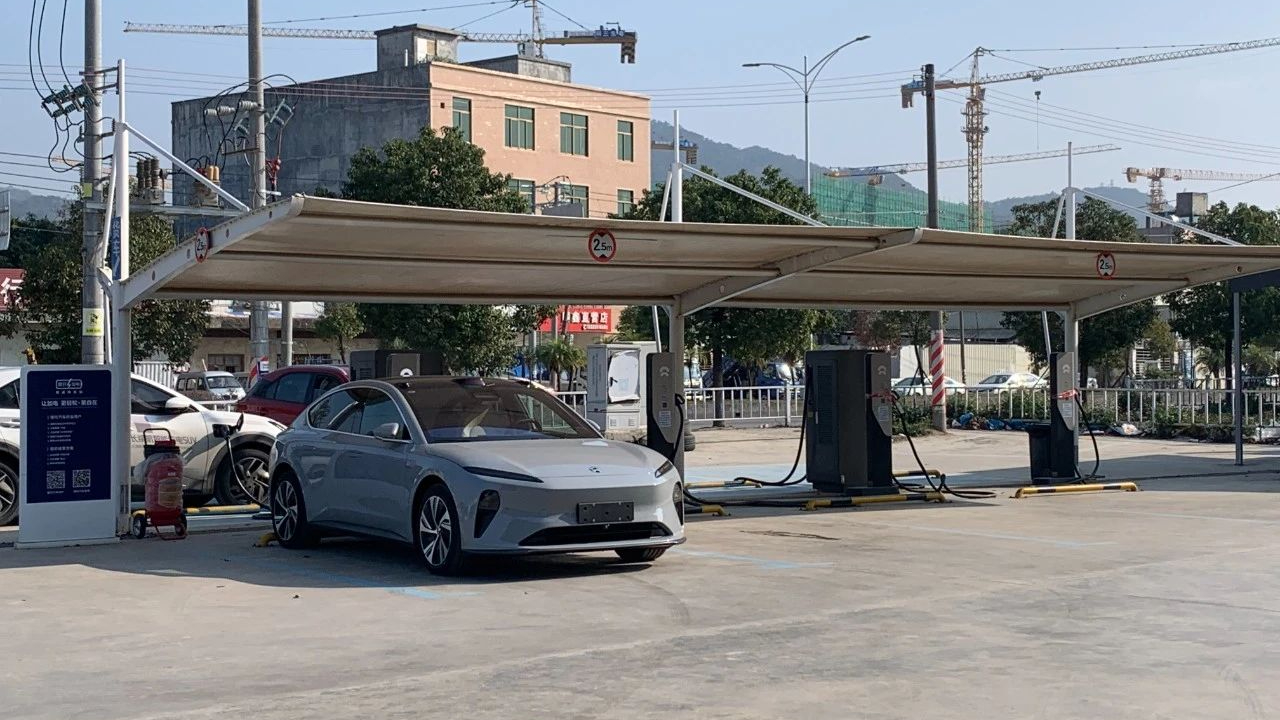Author: Zheng Senhong
At a distance of over 300 kilometers, it is a critical point for pure electric vehicles to achieve “local commuting” to “long-distance use”, and it is also a common one-day trip for self-driving travel.
In the current market competition, the competition for endurance has become a thing of the past. Almost all car manufacturers can raise the range to 400 kilometers, and many mainstream models have already achieved over 600 kilometers.
But car owners understand that the range is a very idealized number. When driving an electric vehicle for long distances, they must consider various uncertainties such as traffic jams, detours, and missing service stations along the way.
Therefore, every time during the return home season, the scene of electric vehicles breaking down occurs repeatedly.
On the one hand, facing the limit of the range and the long-distance journey during the return season is a real adventure. On the other hand, the tidal surge of charging demand during holidays, as well as the insufficient charging facilities, and the lack of operation and maintenance in expressway charging stations make the experience of long-distance travel in electric vehicles during holidays entirely depend on luck.
The joys and sorrows of driving home are not shared by humans. Gasoline car users only think that electric car users are asking for it and are dead set on saving face, while electric car users only think that gasoline car users do not plan well and do not love the Earth.
But it is precisely during a special period like the Spring Festival that I got a NIO ET7 that can be charged and swapped. I plan to drive all the way from downtown Shenzhen to downtown Shantou. In this 350-kilometer holiday long-distance journey, can the battery swap station help electric vehicle users save face?
How much pressure does NIO face with free high-speed battery swapping?
First, the background of the vehicle:
This time, I have a 100kWh NIO ET7 in my hand, with an official range of 675km (CLTC comprehensive working condition). There are no special restrictions on the use of the car scene, mainly close to the real needs of daily travel.

In theory, this range is enough to support the 350-kilometer long-distance travel demand. Coupled with NIO’s high-speed battery swapping station with a spacing of 200 kilometers, I don’t need to plan the travel route as detailed as other electric vehicle users. However, in order to experience the holiday high-speed energy replenishment experience, after driving 255 kilometers, I drove into the NIO battery swap station at the Jieyanghuilai service area on G15 Shenhai Expressway.“`
(1) Due to the long duration of the Spring Festival travel rush, staggered travel has to some extent reduced the pressure and demand for NIO battery swapping stations. On the evening of January 18th, there was no waiting in line and the efficiency of swapping was no less than that of nearby gas stations.
(2) The Jieyang Hulai Service Area on the G15 Shenhai Expressway is NIO’s second-generation battery swapping station. The most intuitive feeling is that on a rainy evening, I can complete the entire swapping process inside the car.
(3) NIO launched a high-speed free battery swapping promotion during the Spring Festival holiday, so this is a welfare benefit for taking advantage of.
(4) During the high-speed free battery swapping period, if there is a queue at the station or no fully charged battery, the station attendant will send a charging link to the car owner through the NIO APP. The owner can then scan the code at a State Grid charging station at the service area and charge for free.
From the data after Chinese New Year, NIO has handed in a perfect score on this big exam.
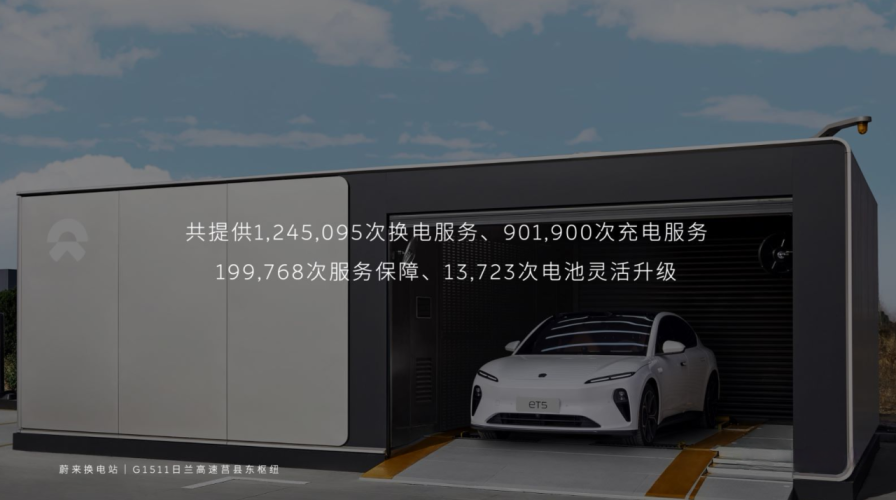
During the Spring Festival, NIO’s battery swapping station provided a total of 1.24 million swapping services, with a peak of 60,000 swaps in a single day. Among them, high-speed free battery swapping accounted for 370,000 swaps, saving car owners about 259,279 hours of high-speed travel time.
Such high replenishment efficiency far surpasses any fast charging station currently available.
What does it mean for swapping to reach a peak of 60,000 swaps in a single day?
It is reported that the daily charging volume of the State Grid service area during the Spring Festival is 2.5 million kWh, which is 2.3 times that of last year. Therefore, NIO’s daily swapping volume exceeding 60,000 times is equivalent to 3 million kWh if calculated at 50 kWh per swap.
From a service perspective, NIO’s high-speed service capacity is no less than that of State Grid.
From a demand perspective, NIO’s high-speed battery swapping network has basically taken shape and can even be said to be NIO’s moat.
NIO CEO Qin Lihong has announced that by 2025, NIO plans to build a high-speed battery swap station network spanning 9 vertical and 9 horizontal lines, and 19 major city clusters. This means that within any interval of 150 kilometers in a high-speed planned section, there will be a battery swap station in any direction.
As of December 2022, NIO has built a high-speed battery swapping network encompassing 5 vertical and 3 horizontal lines and 8 major city clusters.
"Chargeable, swappable and upgradable" has always been NIO's consistent belief. As long as the local power capacity supports it, NIO's charging piles will be located next to the battery swap station, and this applies to the high-speed service area too.
In other words, in addition to the "bug level" service of battery swapping stations on high-speed highways, NIO also has its exclusive supercharging network, which is monitored and maintained by professionals to avoid the occurrence of faulty charging piles.
Following the success of the high-speed free battery swap during the Spring Festival, Qin Lihong said, "We're considering doing this for every Golden Week."
Through the impressive "scene" portrayed by electric vehicles during every homecoming season, it is clear that a self-contained and complete energy supplement system brings significant benefits.
At present, Tesla and XPeng have their own high-speed charging networks, but only NIO has a self-contained system that includes battery swapping stations, supercharging piles, destination charging piles, and mobile charging cars.
Simply put, electric vehicle companies that build their own charging/battery swapping networks do so because they know where their users are and where they go. Infrastructure driven by technology is the key to solving charging problems.
For all NIO users, "driving an electric vehicle home for the Chinese New Year" may no longer be a problem.
## NIO Charging Piles: A "Public Facility" for Electric Vehicle Users in Small and Medium-Sized Cities
Against the background of China's electric vehicle industry's progress from 0 to 1, the number and density of charging/swapping stations at service areas along provincial-level expressways, whether in the Yangtze River Delta or the Pearl River Delta, have basically met the needs of pure electric vehicle long-distance travel.
This is a huge improvement, considering that in 2019, most service areas in Guangdong Province still did not have charging stations.
```
<div>
Besides, the intercity refueling network is also a problem that pure electric vehicle brands cannot avoid.
According to the survey conducted by China EV100, the public charging pile retention rates in third-tier, fourth-tier, and fifth-tier cities are only **17\%**, **6\%**, and **2\%** of the total retention rate in first-tier and new first-tier cities.
After returning to my hometown in Shantou, my biggest surprise was that there was a NIO battery swap station in Chao'yang district of Shantou, a small county town.
Perhaps the coverage rate of NIO users in small county towns is relatively low. I did not encounter any queuing situation during three battery swaps, which means I could swap the battery right away.
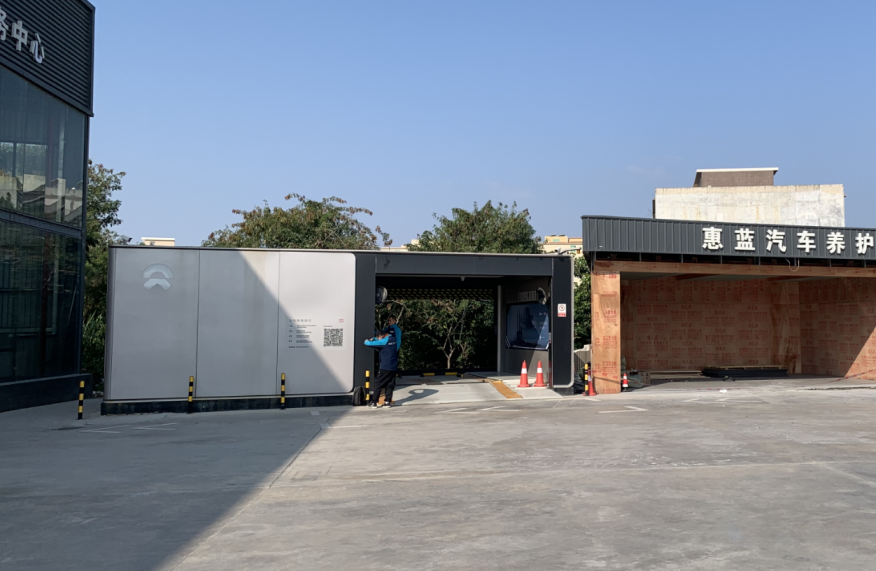
Intercity refueling is a very important scenario. The development of pure electric vehicles will also penetrate from first-tier and new first-tier cities to smaller cities and broader communities, and users' travel scenarios will become more complex, which will amplify the demand for intercity travel.
Zhang Yongwei, Vice Chairman and Secretary-General of China EV100, stated that third tier and lower-tier cities will become an important incremental market in 2022.
Data shows that in 2022, the sales of new energy vehicles in second-, third-, and lower-tier cities will account for **54\%** of the national total. It is predicted that the new energy vehicle market will accelerate its penetration to second-, third-, and lower-tier cities in 2023, and its sales will account for over **60\%** of the total.
On February 6, Qin Lihong shared an interesting dataset during the NIO Spring Festival media communication meeting.
During the Spring Festival, the top three busiest NIO charging stations in China were:
- TaiSheng International, Guiyang: 11,904 sessions
- Liantai Center, Shanghai: 10,414 sessions
- Jin Wenjiang, Chengdu: 6,962 sessions
From these locations, it can be observed that "TaiSheng International" which tops the list is located in a fifth-tier small city in Guiyang, in addition to two first-tier cities, Shanghai and Chengdu.
The data suggests that the lack of charging piles of other brands in the local areas and the scarcity of public charging resources can be reflected. However, it may not reflect the local electric vehicle holdings.
</div>
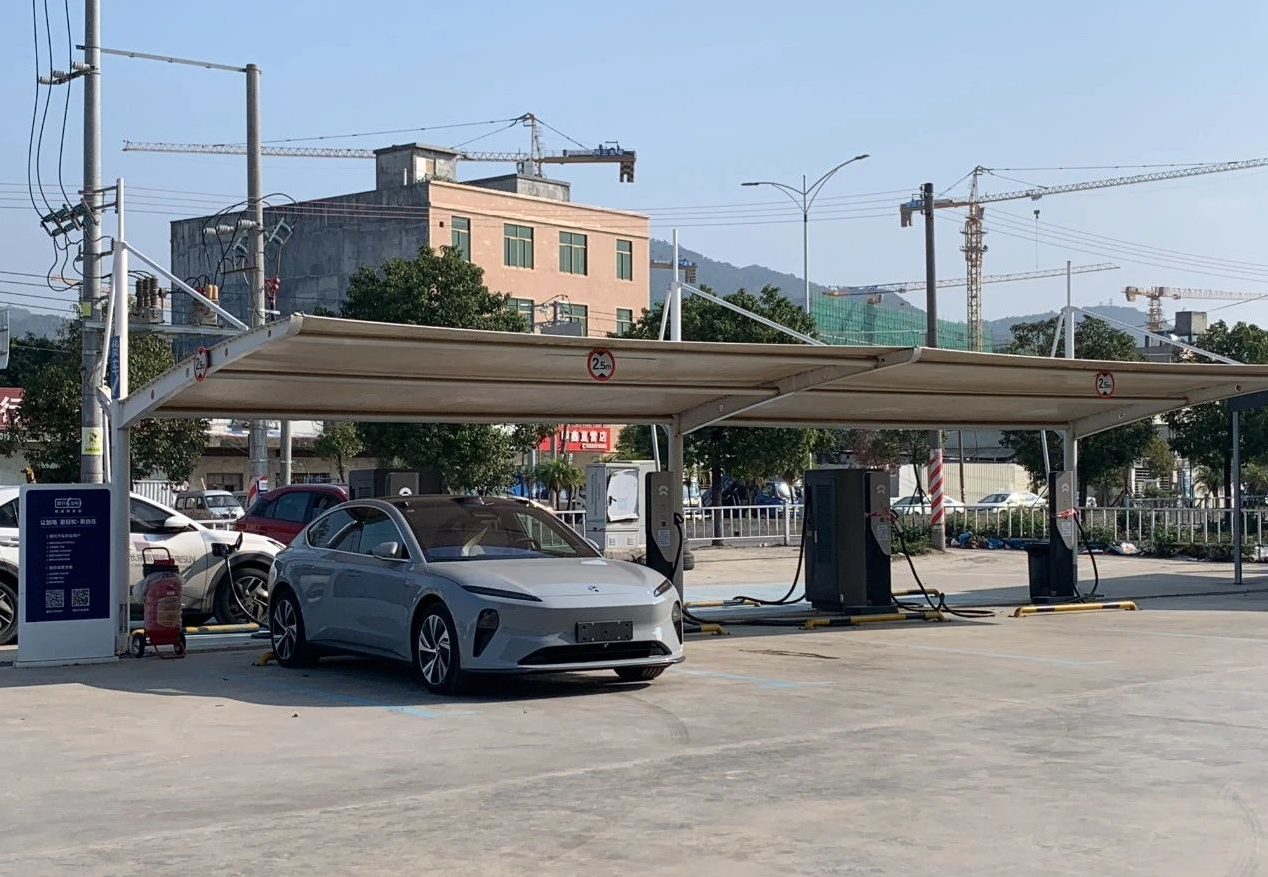
Another piece of data worth reviewing is that during the Spring Festival, 76% of the charging service brand for NIO public charging stations came from non-NIO brands.
Among them, BYD car owners charged more than 4 million kilowatt-hours, accounting for **17.6%**; Tesla car owners charged almost 3.7 million kilowatt-hours, accounting for **15.8%**, followed by brands such as XPeng, ROEWE, Ideal, and Geely.
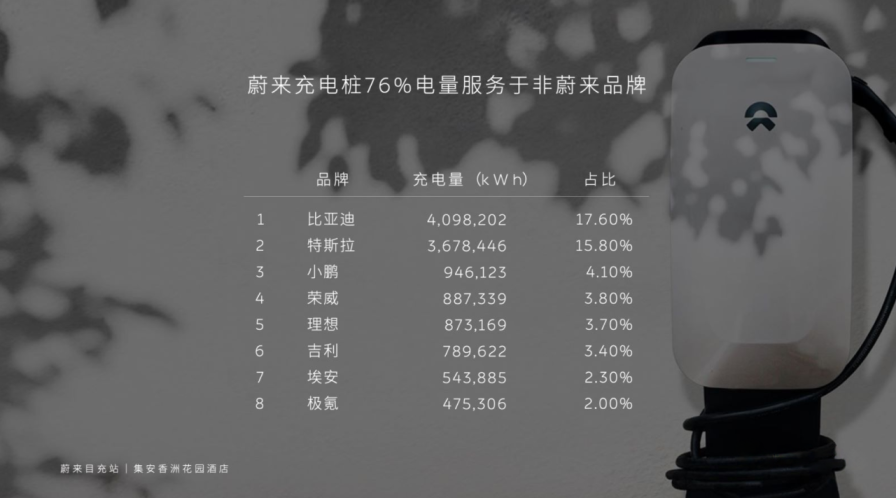
Qin Lihong combined the actual power consumption of the first 8 brands and calculated the mileage to be approximately **80 million kilometers**.
In other words, during the Spring Festival holiday, NIO public charging stations provided these 8 brands with 80 million kilometers of additional energy and endurance, which led Qin Lihong to joke: "As a friendly competitor congratulating you all on good car sales, but here I still want to call for it. Companies that make electric vehicles seriously still need to set up charging stations on their own."
"You may not be aware that NIO is the brand that has built the most charging stations in China,” Qin Lihong continued.
So far, NIO has built **13,629** charging piles, and each charging pile is open to all electric vehicle users in the industry, which means that these more than 13,000 charging piles are both NIO car owners' charging piles and all electric vehicle users' charging piles in China.
It can be seen that whether it is Beijing, Shanghai, Guangzhou, Shenzhen, or second and third tier cities such as Shantou and Guiyang, or small counties like Chaoyang District, NIO's charging/swapping infrastructure has been widely deployed, so as long as you are in the city, charging and swapping has become not a problem.
For NIO users, all the spontaneous trips do not depend on the cruising range, but that with charging/swapping stations available, they can always enjoy the best energy replenishment experience without worrying about encountering "under repair" bad piles.## NIO's Power Supplement Plan
During the 17-day driving experience, covering a total distance of 1,500 kilometers, I needed at least 4-5 times of supplementing power for my ET7 with a 100 kWh battery, which took no less than 4 hours to charge (via mainstream fast charging).
In comparison, I spent less than 1 hour waiting for and completing 5 battery exchanges online after ordering, starting from the time the vehicle drove to within 200 meters of the battery exchange station (measured in a straight line).
On the other hand, based on a personal driving distance of 1,500 kilometers during the Spring Festival (using 92 gasoline as an example, with an average fuel consumption of 10 liters per 100 kilometers), refueling 3 times would cost about CNY 1,100 for a gasoline-powered vehicle.
Excluding the free battery exchanges during the Spring Festival and the 4-6 free battery exchanges provided by NIO every month, my supplementing power cost during the 17 days was zero.
As Qui Li Hong put it, "among Chinese automobile brands, only NIO currently has such a possibility and capability".
By building a NIO power service system consisting of battery exchange stations, supercharging piles, destination charging piles, and mobile charging vehicles, NIO has indeed provided an experience in supplementing power that cannot currently be matched in the market.
That's why NIO launched the "Spring Festival free high-speed battery exchange" program.
Qui Li Hong explained that NIO's infrastructure services have been lacking effective testing over the past two years because of a sharp decrease in traffic volume and a relatively easy demand for daily services.
This year's Spring Festival was the first day of mass travel after the epidemic, and it was a comprehensive test for NIO's service system and guarantee system that has been laid out for years.

After this stress test, Qui Li Hong believes that there are two areas in which NIO's power supplement system could be improved.```
First of all, the goal of "electric charging is more convenient than refueling" can be achieved.
"Electric charging is more convenient than refueling" has always been NIO's early goal, and it is also a goal that many electric vehicle owners dream of achieving.
Qin Lihong believes that if we could handle the extreme situations during peak periods better, and as long as NIO swapping stations are available during holidays for high-speed travel, it should be possible to make electric charging more convenient than refueling.
"When the 9 vertical and 9 horizontal and 19 metropolitan areas are built, we can confidently say that NIO users can make electric charging more convenient than refueling when driving on highways in China," Qin Lihong added.
Secondly, NIO's estimation of the popularity of certain swapping stations is insufficient. Therefore, constant supplemental work is needed for completed high-speed swapping routes.
By the end of 2022, NIO had built a total of 1,305 swapping stations, forming a close-knit "subway" map.
According to the plan, NIO had planned to add 400 new swapping stations in 2023. However, after this holiday test, NIO will add more than 400 swapping stations this year. At present, it is screening addresses and conducting financial calculations nationwide. Clear plans are expected to be announced in February.
It can be seen that "free high-speed swapping" is not only a strategy for NIO to accumulate popularity, but the data behind it actually indicates NIO's clearer and targeted planning on its own supplemental facilities.
After determining the direction of the supplemental layout, the cost investment is also an unavoidable issue for NIO.
秦力洪表示,蔚来卖车的毛利大体等于公司内部管理和营销服务费用(包括补能建设)的总支出,我们亏损的部分约等于研发费用,可以用战略融资来解决,这符合一家成长型科技创新公司的发展逻辑。
举个例子,春节高速不限次数换电额外的成本,主要是电费和人员加班费,两者的费用大概等于王府井广告牌一年的费用,而蔚来只不过把这一部分的营销费用省下来花在用户身上。
「服务」一直是蔚来的主旋律,「场景」是 NIO Power 的逻辑起点,「需求」则成为了蔚来能源技术的驱动力。
总而言之,那句「燃油车能去的地方,电动车都能去」已经逐渐在蔚来身上得到验证。
至少在这个春节假期,已经有 18 位蔚来车主用超过 1 万公里的行驶里程证明了纯电动车也能够说走就走。
“`
This article is a translation by ChatGPT of a Chinese report from 42HOW. If you have any questions about it, please email bd@42how.com.
